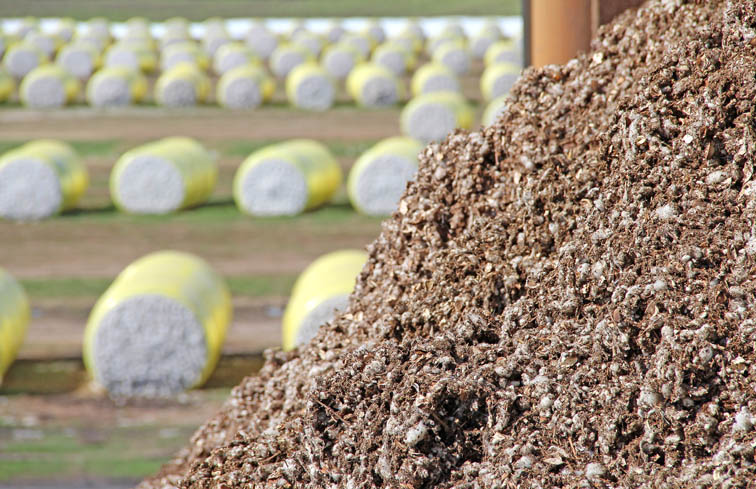February 4, 2013

With the Chinese government sitting on a huge chunk of the current world cotton supply and an outlook for sharp acreage cutbacks in the U.S. this year, support should continue for prices in the 80-cent range, says O.A. Cleveland, Jr.

O.A. CLEVELAND, JR.
“We’re in an exciting cotton market now,” he said at the Mississippi Farm Bureau Federation’s annual commodity conference at Jackson, Miss.
“It’s not the $1.50 to $2.00 excitement we saw in 2010, but it is impressive from the standpoint that many analysts and market experts have been suggesting prices in the 45 cents to 60 cents range. Even the International Cotton Advisory Committee, one of the very best analytical organizations, has suggested we’d be seeing a price somewhere between 65 cents and 75 cents.
��“If you believe in technical analysis, as I very strongly do, it is just a study of the history of prices, and with a world carryover in the neighborhood of 80 million bales — nearly 10 million more than we’ve ever had — history tells us that prices should be at such-and-such a level.”
But, says Cleveland, “There is something different about this particular market — and that difference is China. The Chinese government has taken their entire crop of some 48 million bales and essentially locked it away in their strategic reserve. The government pays cotton growers directly, and this is cotton for which they’ve paid between $1.41 and $1.45.
“They have something over $30 billion invested in this crop, which is almost as much as the USDA’s entire budget for farm commodity programs (not counting its food programs).
“This is a very interesting situation because of the impact it’s having on the world market. People say, well they’ve got all that cotton and they’re just going to let the bottom fall out of the market. But, the Chinese are very astute in finance and marketing, and with all the money they’ve got invested in their own cotton, and with half the world’s cotton supply locked up, it’s not likely they want a big drop in the market.”
China just recently started offering for sale quantities of their cotton, Cleveland says. “They were offering textile mills 2008 crop cotton; now they’re offering 2011 crop cotton. But they’re not getting many takers. They’re only selling about 20 percent to 25 percent what they offer on a daily basis.
“They’re selling middling 1-3/32 cotton to the textile mills for $1.38 per pound roughly. The mills can buy a bale of U.S. cotton and land it in China for $1.27 per pound, with about a 15 percent tariff paid on it. Because of the cost, Chinese textile mills by and large aren’t using Chinese cotton; much of it is imported, some from the U.S.
“Chinese spinning mills aren’t particularly active. The government is officially holding the price of their cotton very high to textile mills, which makes them uncompetitive with international mills. They’ve also maintained a very low polyester price, so Chinese mills can buy polyester 10 percent cheaper than last year. In other markets around the globe, polyester is only 2 percent to 3 percent cheaper. So for whatever reason, China hasn’t lowered their polyester price and they are very favorable toward using polyester in their textile mills.”
Chinese importing cotton yarn
However, Cleveland says, the Chinese are importing yarn. “There is no tariff on importing yarn; it comes in duty-free, which allows the mills to get around the problem of buying expensive cotton. By importing yarn instead, they can compete in the world textile market. Pakistan, India, Vietnam, South Korea, the U.S., are selling yarn to China.
It’s cheaper to import quality U.S. cotton and spin it in China than to buy quality Chinese cotton and spin it in China.”
The Chinese government is preparing to set the 2013 cotton price, he says. “We have no idea what it’s going to be. They’ve not set prices for wheat or other commodities yet, but we’re anticipating they will lower the price of cotton, which will certainly have an impact on their plantings. We expect they will increase their acreage of food grains and feed grains, and information I’m seeing suggests they will reduce cotton production by 10 percent to 15 percent. We’re certainly looking for them to have a significant decrease, as is the case in the U.S.”
The Chinese government, Cleveland says, “is attempting, and more than likely will succeed, to move their cotton production area from the eastern seaboard to the arid far west, where there are very large mechanized farms.
“This is an area that is basically controlled by the Chinese army, which manages all the economic resources of the region. They have six-row equipment and miles ofutility lines for irrigation — it’s as modern as anything we have, and is highly efficient, but the ground and yields aren’t as good as the U.S. But they apparently plan to take the high yielding eastern seaboard area out of cotton so they can increase their production of grains.
“They also have new leadership, with tremendous exposure to western education. All the press has been commenting that the new leadership will be very consumer friendly, and their people will be expecting them to deliver on this. They’re expecting the entire market to be consumer friendly and for the government to pay more attention to them.
“While China is still very much agrarian country, it’s catching up fast in many ways, and many, many people have moved into the middle class. In 10 to 15 years, many analysts are predicting their economy will be larger than ours.
“This is why U.S. cotton exports are considerably larger than what we originally expected,” Cleveland says. “The USDA originally had forecast exports at 11. 2 bales, but that has been creeping up to about 12.2 million bales. Based on what’s been happening, I think we will probably export as much as 13 million bales to China this year, which is over 800,000 bales more than the current USDA estimate.
“I fully believe we’re on a pace to export 12.8 to 13.2 million bales. There is a strong demand for cotton, and the USDA has been slow to recognize this. I have a tremendous respect for USDA and ICAC analysts, and I know they have constraints on their analyses that I don’t have to contend. But I know too that they’re paying a tremendous amount of attention to all that cotton in China and why it’s not on the market.”
The USDA’s current estimate of global mill consumption is about 106 million bales, Cleveland says, but “I would anticipate they will increase that by at least 1 million, maybe 2 million bales. By the end of the marketing year, I think world consumption will be 110 million to 111 million bales — which is 4 million to 5 million bales more than the USDA is projecting right now.
“We’re seeing increases in Bangladesh, Turkey, Vietnam, Cambodia, Laos, South Korea, and other countries with growing textile operations. Their mills are spinning to export yarn to China.
“Also, Chinese textile mill owners and textile investors are moving cotton outside out of China into these countries, and building new mills because China is becoming more expensive. The Chinese working class is expanding, people are moving away from the farm and subsistence agriculture into town and businesses. China is no longer the lowest price textile producer, but Cambodia, Vietnam, India, Pakistan are still low cost wage countries.”
India is “the bright star on the horizon as far as cotton goes,” Cleveland says. “Their yields have more than doubled in the last 10 years, and they’re in for another 50 percent increase, if not more.
“It’s still a country with lots of very small fields and very inefficient production, but as they begin to become more efficient they will become more and more a player in cotton. They will one day out-produce China and spin more cotton than China, whether it be 10 years from now or 15 years from now.”
You May Also Like




